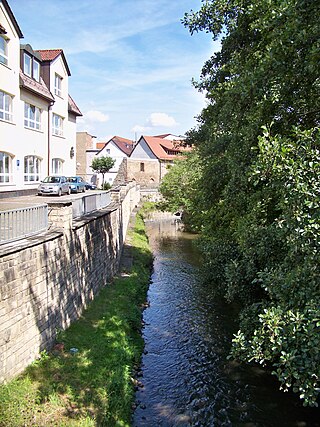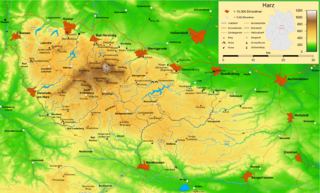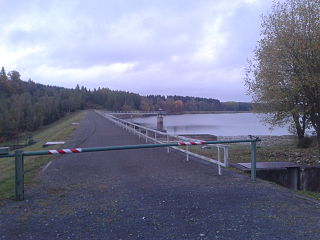
The Duchy of Anhalt was a historical German duchy. The duchy was located between the Harz Mountains in the west and the River Elbe and beyond to the Fläming Heath in the east. The territory was once ruled by the House of Ascania, and is now part of the federal state of Saxony-Anhalt.

Gernrode is a historic town and former municipality in the Harz District, in Saxony-Anhalt, Germany. Since 1 January 2014, it has been part of Quedlinburg. It was the seat of the former Verwaltungsgemeinschaft of Gernrode/Harz.

Ballenstedt is a town in the Harz district, in the German state of Saxony-Anhalt.

Güntersberge is a village and a former town in Harz District, in Saxony-Anhalt, Germany. It has held the status of an officially recognized resort town since 2001. Güntersberge, together with the other municipalities of the former Verwaltungsgemeinschaft Unterharz, merged into the town of Harzgerode as of 1 August 2009.

Harzgerode is a town in the district of Harz in Saxony-Anhalt, Germany.

Straßberg is a village and a former municipality in the district of Harz, Saxony-Anhalt, Germany. Since 1 August 2009, it is part of the town Harzgerode. Straßberg is located in southeastern part of the Harz mountains, 20 km south of Quedlinburg, 22 km northeast of Nordhausen and 23 km northwest of Sangerhausen.

Christian I, Prince of Anhalt-Bernburg, also known as Christian of Anhalt, was a German prince of the House of Ascania. He was ruling prince of Anhalt and, from 1603, ruling prince of the revived principality of Anhalt-Bernburg. From 1595 he was governor of Upper Palatinate, and soon became the advisor-in-chief of Frederick IV, Elector Palatine.

Alexisbad is a small spa town, part of Harzgerode in the district of Harz, Saxony-Anhalt, Germany.

The Wipper is a river in Saxony-Anhalt, Germany. A left tributary of the Saale, the Wipper is 85 kilometres (53 mi) long. Its name comes from the old German word Uipparaha, which means "singing, bouncing river".

The Principality of Anhalt was a State of the Holy Roman Empire, located in Central Germany, in what is today part of the federal state of Saxony-Anhalt.

Anhalt-Harzgerode was a small principality of the Holy Roman Empire, ruled by the House of Ascania with its residence at Harzgerode in present-day Saxony-Anhalt. It was created in 1635 following the partition of Anhalt-Bernburg with Frederick, a younger son of Prince Christian I becoming the reigning prince. The death of Frederick's son Prince William Louis in 1709 resulted in the extinction of the ruling family and Anhalt-Harzgerode was reunited with Anhalt-Bernburg.
Nienburg Abbey was a Benedictine monastery in Nienburg in Saxony-Anhalt, Germany.

Frederick of Anhalt-Harzgerode, was a German prince of the House of Ascania and the first ruler of the principality of Anhalt-Harzgerode.

Anhalt Castle is a ruined medieval fortification near the town of Harzgerode in Saxony-Anhalt, Germany.

Heinrichsberg Castle is a ruin north of Mägdesprung in the borough of Harzgerode in central Germany. It is not far from the B 185 federal road in the district of Harz in the state of Saxony-Anhalt.
Silberhütte is a village in the town of Harzgerode in the district of Harz in the German state of Saxony-Anhalt. Its name means "silver works", a place where silver ore is smelted.

Within the Lower Harz region are still many traces of the historical water management facilities used by the mining industry. In addition to water-carrying ditches and ponds, there are also long-abandoned ditches and dry pond beds. The Lower Harz Pond and Ditch System, which forms the major part of these old water management facilities, lies in the central Lower Harz, almost entirely within the borough of the present-day town of Harzgerode.

Mägdesprung is a village in the municipality of Harzgerode in the district of Harz. It nestles in the Harz Mountains at a height of 295 m.

The Teufelsteich was one of the oldest reservoirs in the Harz Mountains of central Germany.




















